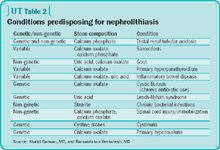Article
Recurrent stone disease: Steps for practical management
Author(s):
Between 30% and 60% of calcium oxalate stone patients have hypercalciuria in the absence of raised serum calcium levels.



Etiology and medical history


Hypercalciuria can be classified into absorptive, renal, and resorptive types, and denotes abnormalities in intestinal absorption of calcium, renal handling of the filtered calcium load, and excessive bone resorption due to elevated serum parathyroid hormone, respectively. Investigators maintain that many patients suffer from a combination of absorptive and renal hypercalciuria. Currently, no prospective randomized trial demonstrates that specific therapy directed at absorptive or renal hypercalciuria is more successful than are non-specific methods for lowering hypercalciuria in preventing stone recurrence.
Newsletter
Stay current with the latest urology news and practice-changing insights — sign up now for the essential updates every urologist needs.





